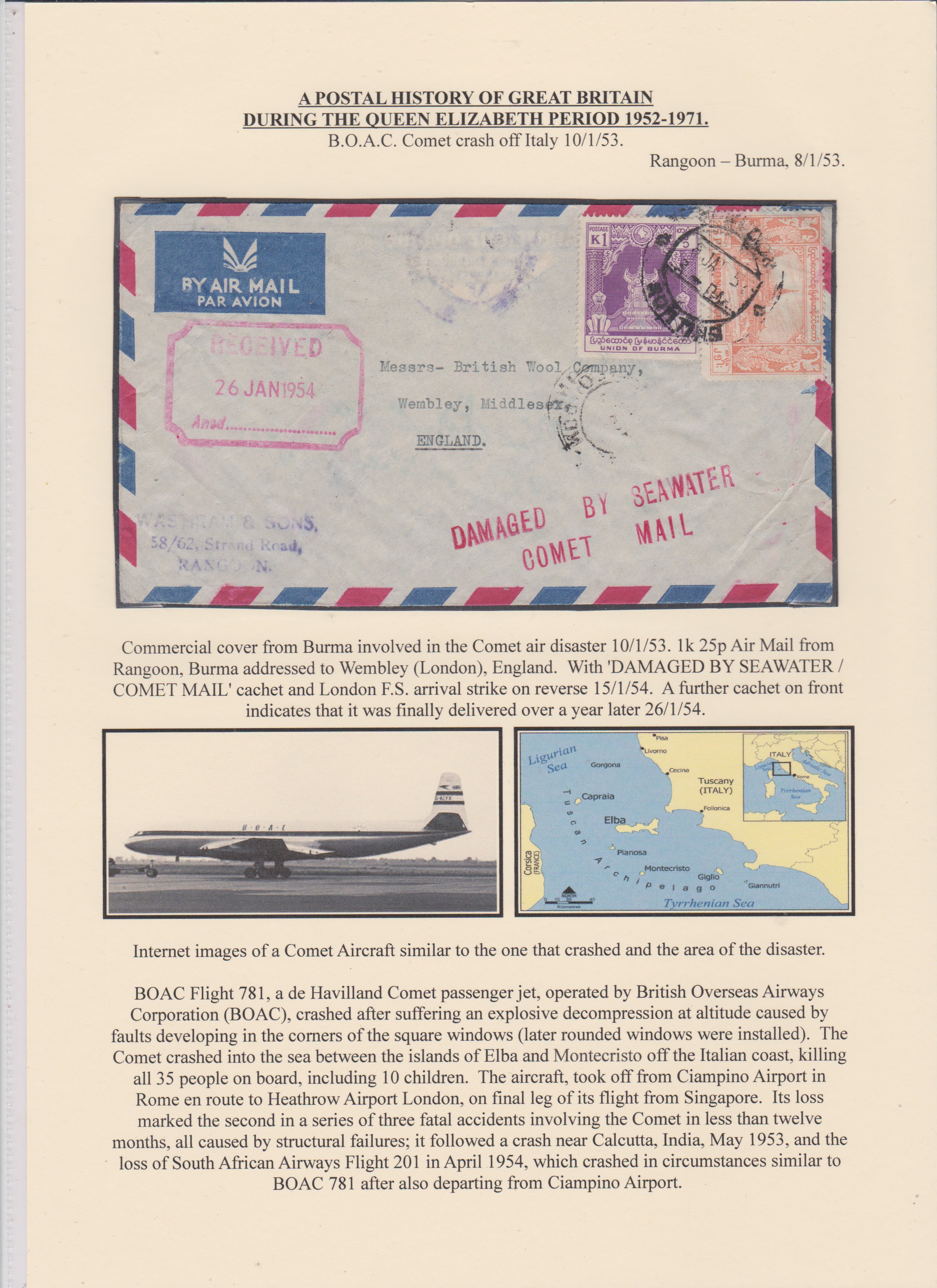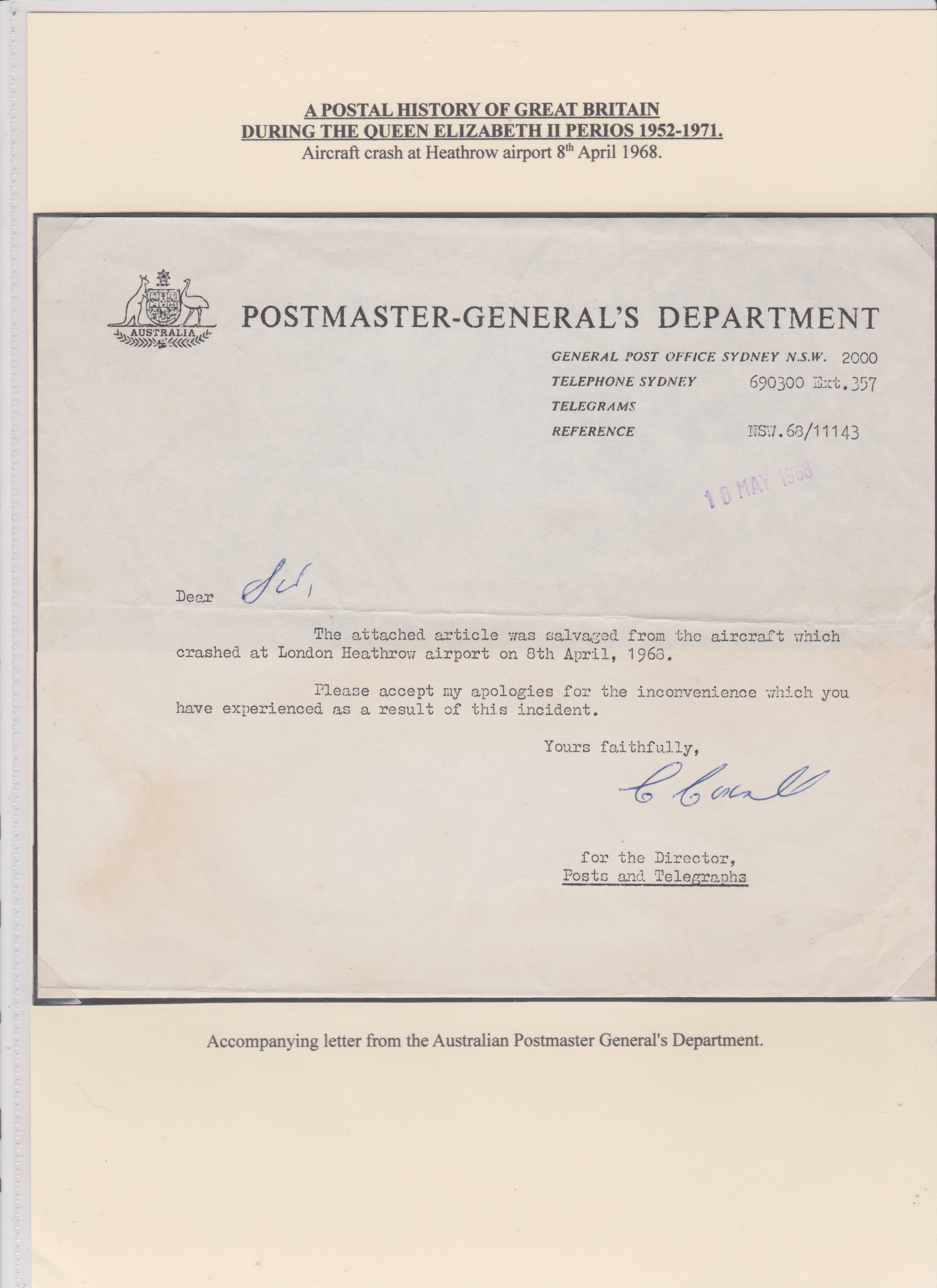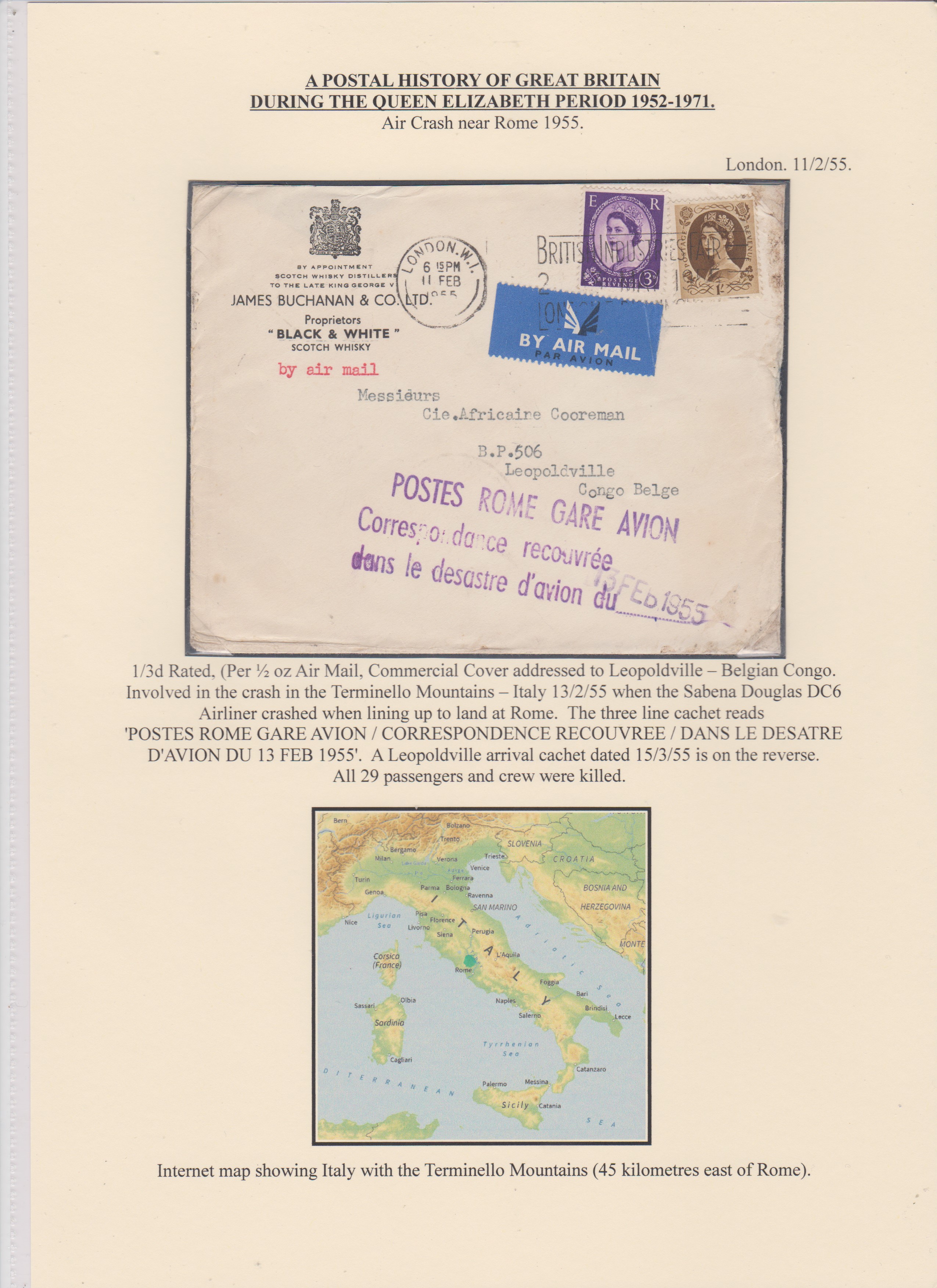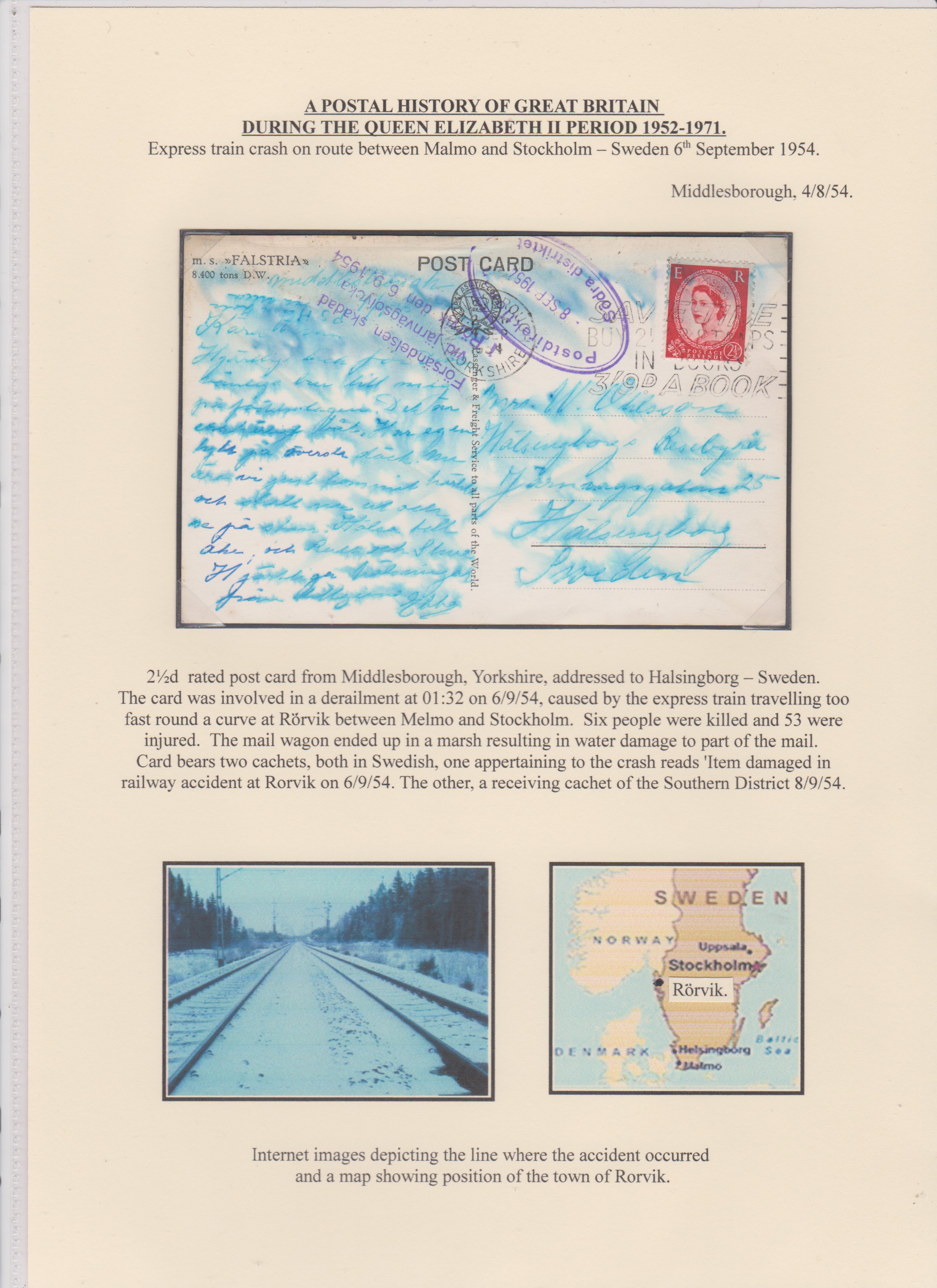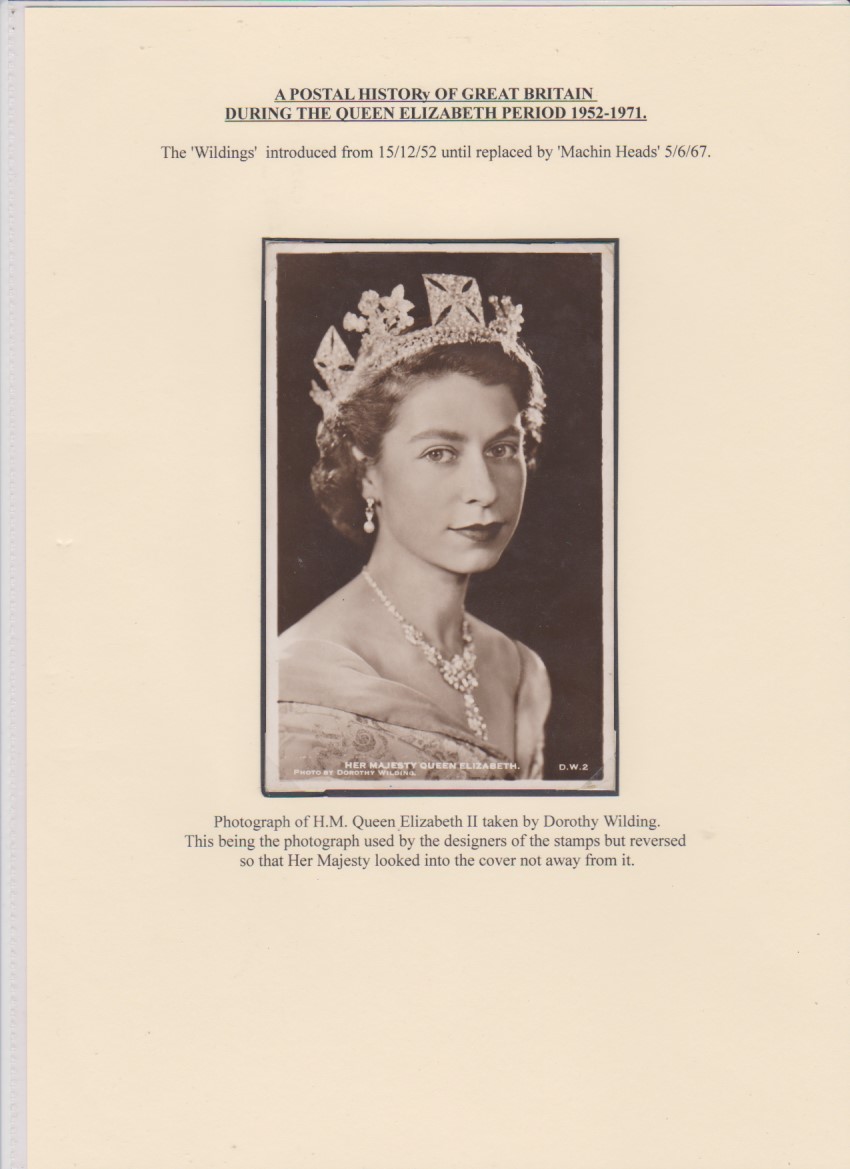Collecting Queen Elizabeth II 'Crash' Mail.
Quote from Jamie Smith on September 30, 2020, 6:27 pmCOLLECTING QUEEN ELIZABETH II 'CRASH' MAIL.
I suppose the first question that arises is, why collect a gruesome subject like crash mail? And the second question would be why do I collect it?
I can only answer for myself so I will join the two questions together. I found early on when I first started collecting postal history that without even collecting the subject that I had had three crash covers in my collection. One was a cover from Khartoum to Nairobi which had a newspaper cutting with it that described the misfortune of the 'Pelican' which had crashed off Kisumu in Kenya. The second was from an aircraft that had crashed near Sir Lowy's Pass in the Cape, South Africa. And the third was a 'Dan Pienaar' P.O.W. card which was involved in the crash of a military Lodestar aircraft again off Kisumu when the South African General and his fellow travelers were killed when returning home for Christmas 1942. I believe these covers give the answers. Crash covers are part of history, which also includes aviation history and in our case postal history.
In my case you can add to this that I had the privilege of being an acquaintance of Captain Dawie Uys who died on 28th November 1987 when the Helderberg of which he was the pilot, crashed into the Indian Ocean killing all on board. We were both members of the Johannesburg Philatelic Society and we both collected 'crash' mail. I will add here that I believe his collection went down with the Helderberg as at the time it was said that he had taken it to Taiwan to be photographed for the plates in a book that he had written on the subject (there were rumours at the time that the collection was recovered and was seen by a philatelist when laid out in a hanger at Jan Smuts Airport with the rest of the aircraft which was recovered from the Indian Ocean – It was never seen again). I remember at one time we each owned one of the 'at that time' only two known 'Dan Pienaar' covers; that was until Peter Vogenbeck turned up with a third. The night that Peter found his cover, which incidentally was at the East London National Exhibition of 1985, the three of us walked up the steps of the hotel together to where the Exhibition dinner was being held not only to have dinner and to celebrate Peter's discovery but to hear the guest speaker who that night was Bob Kershaw who because of his involvement in the rescue of a fellow airmen when he was shot down and crashed during the Italian Campaign was depicted on the South African War Effort 1½d stamp. Need I say more?
My collection which now, because I collect Queen Elizabeth II postal history is confined to the pre-decimal period of her reign which by its very nature makes it a small collection and is not confined to aircraft crashes but includes a small percentage of railway disasters as well. It can be divided into two sections; the first is British aircraft that crashed and foreign aircraft and trains that crashed while carrying British mail on them.
As far as I am aware the main crashes and the ones that I record in my collection during the Queen's reign were.
The Isle of Elba crash 10/1/53 when a de Havilland 'Comet' of British Overseas Airways Corporation (B.O.A.C.) suffered an explosive decompression and crashed into the sea between the islands of Elba and Montecristo off the Italian coast killing all 35 people aboard.
The Calcutta crash 2/5/53 which was also a de Havilland Comet. It was surmised that the cause was a pressurisation problem that had caused metal fatigue which caused the aircraft to explode in mid-air killing all 43 passengers and crew. (It would appear that there were more than 20 such accidents involving de Havilland Comets).
The Singapore crash of 13/3/54 where a Super Constellation again of B.O.A.C. landed ten feet short of the runway, hit a ramp causing damage which upon bouncing and landing further up the runway caused the aircraft to 'roll' and catch fire. The accident was blamed on the captain who had been without sleep for 21 hours. There were only seven survivors from the 40 passengers and crew on board. Philatelically this crash is of particular interest as 'Wildings' appear on covers addressed into the United Kingdom from British forces serving in the Far East using concession rates at British Forces Post Offices (B.F.P.O.).
The 'Prestwick' crash of Christmas Day 25/12/54, when a B.O.A.C. Boeing 377 Stratocruiser crashed when attempting to land at Prestwick Airport in Glasgow, Scotland. The aircraft landed short of the runway, there was also a problem with the landing lights being turned on too late. 28 of the 36 on board were killed. There are two cachets recorded, I only show one. These covers are by far the commonest.
The Ankara crash at Esenboga Airport 21/12/61. A de Havilland Comet of British European Airways crashed killing 27 of the 34 people on board. The accident was blamed on a loose screw which blocked the pointer in an instrument which caused the pilot to climb too steeply which in turn caused the aircraft to crash.
The Heathrow crash 8/4/68 when a Boeing 707-465 of B.O.A.C. lost an engine which had caught fire after take off. After making a successful landing a fire broke out causing the death of 5 of the 127 people on board.
Of foreign crashes carrying British 'out-going' mail I have recorded the following.
The Moose Jaw crash in Canada 23/3/54, where a North Star of Trans-Canada Air Lines collided with a Canadian Air Force Harvard training aircraft killing 37 people.
The Italian 'Terminello Mountains' crash 13/2/55 which occurred when a Douglas D.C.6 of Sabena Airways crashed when descending to Rome's Ciampino Airport, killing all 29 people on board. The accident was blamed on being blown off course during a gale.
The Hawaai (Pacific Ocean) crash 8/11/57. A Boeing 377-10-29 Stratocruiser belonging to Pan Am crashed into the Pacific Ocean 900 miles from Hawaii whilst on a flight from San Francisco killing all 36 passengers and 8 crew on board as far as I am aware no cause was ever found for the accident.
The Swedish Rorvik railway derailment/crash 6/9/54. The accident was blamed on an express train travelling too fast on a curved line resulting in the derailment and 6 deaths. Two types of cachet were used, I show both.
The Portuguese 'Salamanca' railway crash 18/12/65. The crash occurred when the Sud-Express crashed head-on into a local train at a village station about 25 miles from Salamanca. 26 people were killed and at least 60 were injured. The only 'legal' way that a cover with a 2½d British stamp could have paid for this rate is if the person sending it was Portuguese and serving with the British military and was writing home to his country of domicile (using the 'British Forces' concession rate); if this was the case the cover should have been endorsed as such (which it was) but the 'Forces' has been crossed out (by an uninformed postal worker?).
I have no doubt that my list is far from complete. Any forthcoming information will be most welcome.
COLLECTING QUEEN ELIZABETH II 'CRASH' MAIL.
I suppose the first question that arises is, why collect a gruesome subject like crash mail? And the second question would be why do I collect it?
I can only answer for myself so I will join the two questions together. I found early on when I first started collecting postal history that without even collecting the subject that I had had three crash covers in my collection. One was a cover from Khartoum to Nairobi which had a newspaper cutting with it that described the misfortune of the 'Pelican' which had crashed off Kisumu in Kenya. The second was from an aircraft that had crashed near Sir Lowy's Pass in the Cape, South Africa. And the third was a 'Dan Pienaar' P.O.W. card which was involved in the crash of a military Lodestar aircraft again off Kisumu when the South African General and his fellow travelers were killed when returning home for Christmas 1942. I believe these covers give the answers. Crash covers are part of history, which also includes aviation history and in our case postal history.
In my case you can add to this that I had the privilege of being an acquaintance of Captain Dawie Uys who died on 28th November 1987 when the Helderberg of which he was the pilot, crashed into the Indian Ocean killing all on board. We were both members of the Johannesburg Philatelic Society and we both collected 'crash' mail. I will add here that I believe his collection went down with the Helderberg as at the time it was said that he had taken it to Taiwan to be photographed for the plates in a book that he had written on the subject (there were rumours at the time that the collection was recovered and was seen by a philatelist when laid out in a hanger at Jan Smuts Airport with the rest of the aircraft which was recovered from the Indian Ocean – It was never seen again). I remember at one time we each owned one of the 'at that time' only two known 'Dan Pienaar' covers; that was until Peter Vogenbeck turned up with a third. The night that Peter found his cover, which incidentally was at the East London National Exhibition of 1985, the three of us walked up the steps of the hotel together to where the Exhibition dinner was being held not only to have dinner and to celebrate Peter's discovery but to hear the guest speaker who that night was Bob Kershaw who because of his involvement in the rescue of a fellow airmen when he was shot down and crashed during the Italian Campaign was depicted on the South African War Effort 1½d stamp. Need I say more?
My collection which now, because I collect Queen Elizabeth II postal history is confined to the pre-decimal period of her reign which by its very nature makes it a small collection and is not confined to aircraft crashes but includes a small percentage of railway disasters as well. It can be divided into two sections; the first is British aircraft that crashed and foreign aircraft and trains that crashed while carrying British mail on them.
As far as I am aware the main crashes and the ones that I record in my collection during the Queen's reign were.
The Isle of Elba crash 10/1/53 when a de Havilland 'Comet' of British Overseas Airways Corporation (B.O.A.C.) suffered an explosive decompression and crashed into the sea between the islands of Elba and Montecristo off the Italian coast killing all 35 people aboard.
The Calcutta crash 2/5/53 which was also a de Havilland Comet. It was surmised that the cause was a pressurisation problem that had caused metal fatigue which caused the aircraft to explode in mid-air killing all 43 passengers and crew. (It would appear that there were more than 20 such accidents involving de Havilland Comets).
The Singapore crash of 13/3/54 where a Super Constellation again of B.O.A.C. landed ten feet short of the runway, hit a ramp causing damage which upon bouncing and landing further up the runway caused the aircraft to 'roll' and catch fire. The accident was blamed on the captain who had been without sleep for 21 hours. There were only seven survivors from the 40 passengers and crew on board. Philatelically this crash is of particular interest as 'Wildings' appear on covers addressed into the United Kingdom from British forces serving in the Far East using concession rates at British Forces Post Offices (B.F.P.O.).
The 'Prestwick' crash of Christmas Day 25/12/54, when a B.O.A.C. Boeing 377 Stratocruiser crashed when attempting to land at Prestwick Airport in Glasgow, Scotland. The aircraft landed short of the runway, there was also a problem with the landing lights being turned on too late. 28 of the 36 on board were killed. There are two cachets recorded, I only show one. These covers are by far the commonest.
The Ankara crash at Esenboga Airport 21/12/61. A de Havilland Comet of British European Airways crashed killing 27 of the 34 people on board. The accident was blamed on a loose screw which blocked the pointer in an instrument which caused the pilot to climb too steeply which in turn caused the aircraft to crash.
The Heathrow crash 8/4/68 when a Boeing 707-465 of B.O.A.C. lost an engine which had caught fire after take off. After making a successful landing a fire broke out causing the death of 5 of the 127 people on board.
Of foreign crashes carrying British 'out-going' mail I have recorded the following.
The Moose Jaw crash in Canada 23/3/54, where a North Star of Trans-Canada Air Lines collided with a Canadian Air Force Harvard training aircraft killing 37 people.
The Italian 'Terminello Mountains' crash 13/2/55 which occurred when a Douglas D.C.6 of Sabena Airways crashed when descending to Rome's Ciampino Airport, killing all 29 people on board. The accident was blamed on being blown off course during a gale.
The Hawaai (Pacific Ocean) crash 8/11/57. A Boeing 377-10-29 Stratocruiser belonging to Pan Am crashed into the Pacific Ocean 900 miles from Hawaii whilst on a flight from San Francisco killing all 36 passengers and 8 crew on board as far as I am aware no cause was ever found for the accident.
The Swedish Rorvik railway derailment/crash 6/9/54. The accident was blamed on an express train travelling too fast on a curved line resulting in the derailment and 6 deaths. Two types of cachet were used, I show both.
The Portuguese 'Salamanca' railway crash 18/12/65. The crash occurred when the Sud-Express crashed head-on into a local train at a village station about 25 miles from Salamanca. 26 people were killed and at least 60 were injured. The only 'legal' way that a cover with a 2½d British stamp could have paid for this rate is if the person sending it was Portuguese and serving with the British military and was writing home to his country of domicile (using the 'British Forces' concession rate); if this was the case the cover should have been endorsed as such (which it was) but the 'Forces' has been crossed out (by an uninformed postal worker?).
I have no doubt that my list is far from complete. Any forthcoming information will be most welcome.
Uploaded files:Quote from Jamie Smith on November 20, 2020, 7:41 amG. B. Queen Elizabeth II Postal History. From today I will be posting '5 a day' from my collection. I anticipate it will take +- four months.
G. B. Queen Elizabeth II Postal History. From today I will be posting '5 a day' from my collection. I anticipate it will take +- four months.
Uploaded files:Quote from yannisl on November 20, 2020, 1:24 pmThanks for posting these. Looking forward to see more of the "Wildings". No. 2 and No.3 image seem to be the same in error.
Thanks for posting these. Looking forward to see more of the "Wildings". No. 2 and No.3 image seem to be the same in error.
Quote from Jamie Smith on November 20, 2020, 2:05 pmYes, I was just checking to see if any one was watching. That's my story and I'm sticking too it!!!!!!!!!!!!!!!!!!!!!! Thanks.
Yes, I was just checking to see if any one was watching. That's my story and I'm sticking too it!!!!!!!!!!!!!!!!!!!!!! Thanks.
Quote from Jamie Smith on November 21, 2020, 6:12 amElizabeth II continued.
Elizabeth II continued.
Uploaded files:Quote from Jamie Smith on November 22, 2020, 8:16 amDiplomatic bag from Russia to post office cachets. The South African 1/2d Dounne (Customs) is of interest.
Diplomatic bag from Russia to post office cachets. The South African 1/2d Dounne (Customs) is of interest.
Uploaded files:


